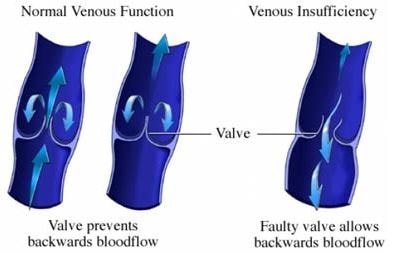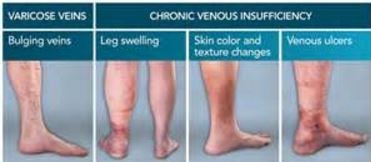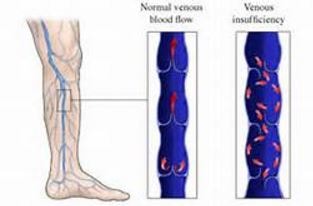Venous Insufficiency
What is Venous Insufficiency?
The arteries carry out blood coming from the heart and throughout the rest of the body. The veins serve as the blood vessels that returns blood back to the heart which came from the organs, arms, and legs, while the valves found in the veins prevent the blood from flowing back.

When the veins have difficulty in delivering blood from the limbs and returning it back to the heart, it is known as venous insufficiency (VI). This type of condition prevents blood from flowing back correctly to the heart which will lead for the blood to pool in the legs.
What are the Symptoms of Venous Insufficiency?
Venous insufficiency has several symptoms. These include:
- A prickling and itching sensation
- Inflammation of the legs
- Certain changes in color around the ankle area
- Cramping in the legs
- Slow healing of wound found on the ankles or legs
- Dull throbbing pain and heaviness of the legs
- Ulcers that develop on the ankles and legs
- Skin redness of legs and ankles
- Feeling of intense pain on standing position
- An aching pain that gets better when legs are raised
- Ropy veins or varicose veins that are seen prominently
- Skin of the ankles and legs hardens and thickens
Immobilization and certain medications may also have some effects to the veins and muscles of the legs. Individuals with this condition must also consider the signs and symptoms of this problem before traveling somewhere or having surgery.

What Causes Venous Insufficiency?
The valves in the deeper leg veins are the ones that keep blood in moving forward towards the heart. In the case of venous insufficiency, the flow of blood through the veins is blocked like that of a blood clot or the blood flow leaks backward through the damaged valves.
For most cases of this condition, individuals have both backward vein leakage and the obstruction of forward blood flow. Usually, the condition is caused by varicose veins wherein the valves are either damaged or missing. Blood clot is another factor that can cause this condition.
The weakening of the muscles in the legs that squeezes blood forward can also serve as a cause for the condition. VI is commonly seen in women than in men. Besides the causes, it is also important to know about the risk factors leading to VI. Some of these are obesity, cancer, pregnancy, smoking, history of the condition in the family, and prolonged standing or sitting positions.
Diagnosis
To determine if the person has venous insufficiency, the physician will have to do some physical examination and ask about the symptoms that had been experienced and complete medical history. The diagnosis is mostly made in accordance to the appearance of the veins of the leg when in a standing position or seated with the legs dangling.
The physician might also order a few imaging tests to point out the root of the problem. These tests can be a duplex ultrasound or a venogram. A duplex ultrasound exam of the leg will be ordered to evaluate the flow of blood, rule out possible problems with the legs, and assess the structure of leg veins.
In a venogram, the physician will put an intravenous contrast dye to the veins of the patient. The dye will give the physician a clearer X-ray image of the blood vessels.
How is Venous Insufficiency Treated?
The treatments for venous insufficiency will depend on certain factors which include the age, symptoms, toleration of medications, causes of the condition and the specific health history and status of the patient.
The most common treatment is the compression stockings to reduce swelling and improve blood flow. The physician may also suggest keeping the legs elevated, doing a daily exercise, wound care and loss some pounds if overweight.
There are also medications that can help such as diuretics which can draw additional fluid from the body; anticoagulants which are blood thinners; and pentoxifylline which regulates blood flow in the circulation. Sclerotherapy involves a chemical that is injected into the vein, so that the vein will not be able to carry blood anymore.
Ablation is another treatment option in which heat is used to destroy the vein. For severe cases, surgical treatment is required. Some surgery types include repairing the valves, stripping a vein that is damaged, endoscopic surgery, and vein bypass which is considered as the last sort wherein a healthy vein is transplanted in the body.
Prevention
If there had been a history of venous insufficiency in the family, some steps can still help to lessen the chances of acquiring the condition. These steps involves having a regular exercise, not smoking, maintaining a healthy body weight, and not standing or sitting in one position for too long.
ICD 9 Code
ICD 9 CM 459.81 is a medical code which can be billable in cases of patients with the diagnosis of venous or peripheral insufficiency for the purpose of reimbursement claim with a service date on or before September 30, 2015. ICD 10-Codes are used for claims with a service date on or after October 1, 2015, which is version 2015/16 ICD-10 CM I87.2.
Pictures


References:
http://www.healthline.com/health/venous-insufficiency#Treatment5
https://www.nlm.nih.gov/medlineplus/ency/article/000203.htm
How is venous insufficiency treated?, How can venous insufficiency be prevented? at https://my.clevelandclinic.org/services/heart/disorders/hic_Venous_Insufficiency
Abbade LP, Lastoria S, Rollo Hde A. (2011 Apr). Venous ulcer: clinical characteristics and risk factors. Int J Dermatol. 50(4):405-11.
Carrasco OF, Ranero A, Hong E, Vidrio H (2009 Dec-2010 Jan). Endothelial function impairment in chronic venous insufficiency: effect of some cardiovascular protectant agents. Angiology. 60(6):763-71.
Renner R, Gebhardt C, Simon JC, Seikowski K (2009 Nov). Changes in quality of life for patients with chronic venous insufficiency, present or healed leg ulcers. J Dtsch Dermatol Ges. 7(11):953-61.
